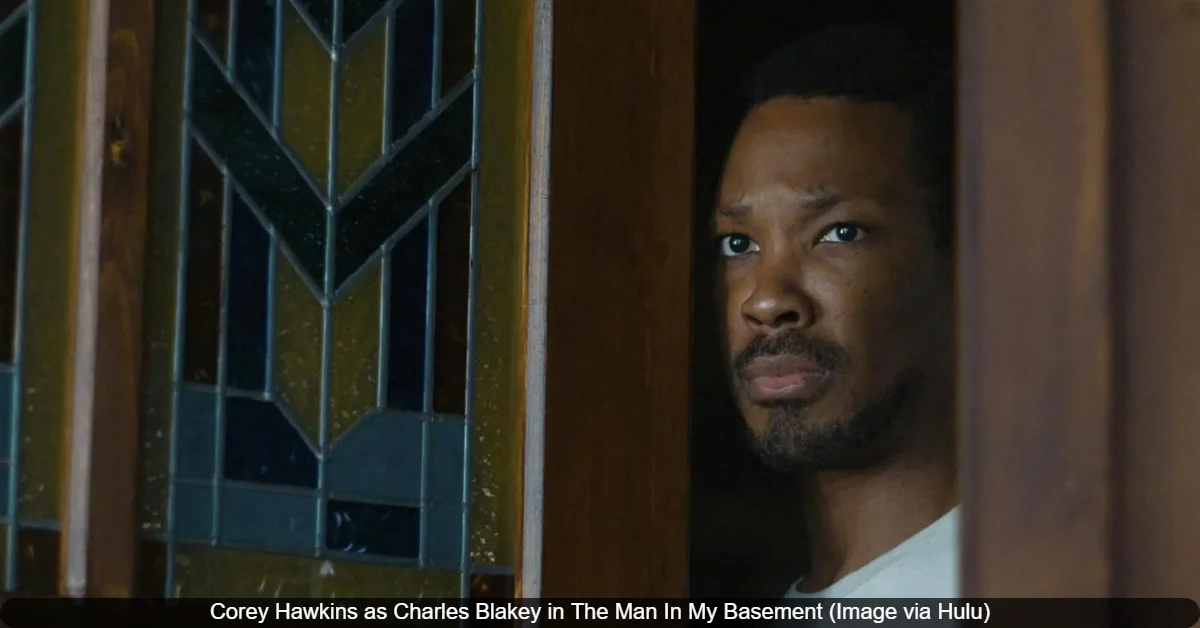In the new movie “The Man in My Basement,” a desperate man agrees to lock a wealthy stranger in his basement, starting a tense psychological game. The film, directed by Nadia Latif and based on Walter Mosley’s novel, stars Corey Hawkins as Charles Blakey and Willem Dafoe as Anniston Bennet. It explores heavy themes of guilt, race, and power. The story ends in a way that leaves viewers with big questions, so let’s break down what really happened in that basement.
The Unusual Agreement
Charles Blakey is having a very hard time. He is broke, unemployed, and about to lose his family’s home in Sag Harbor to the bank. Just when things seem hopeless, a mysterious and wealthy white man named Anniston Bennet shows up at his door with a strange offer. He wants to rent Charles’s basement for $65,000.
Charles, seeing no other way to save his house, agrees. But on the first day, he discovers something shocking in his basement. Bennet has built a metal prison cell and plans to live inside it for the next two months. He gives Charles the only key, making Charles his jailer. Bennet says he wants to be locked away to atone for crimes he has committed, but Charles soon realizes he is part of a much more complicated plan.
Why Bennet Chose Charles
At first, Bennet’s reasons seem simple. He tells Charles he has done bad things in his life and feels he deserves to be punished. He says Charles is the perfect man to be his warden because he is a Black man, and Bennet, as a white man of power, has hurt Black communities. He tells Charles:
“You are the perfect specimen—lonely, in debt, and with a house with a basement.”
However, it is later revealed that Bennet’s choice was not random. He had been studying Charles and knew everything about his financial troubles and his past. In fact, Bennet admits he was the one who pressured the bank to foreclose on Charles’s house. He created the very crisis that forced Charles to accept his offer. Bennet did not just find a man in a bad situation; he created one to exploit.
The Shift in Power
Even though Bennet is the one in the cage, he often seems to be the one in control. He knows private details about Charles’s life, like a past theft from a bank that got Charles fired. Their conversations are intense, with Bennet pushing Charles to see his own failures and the ways he has neglected his family’s history.
Charles discovers valuable African artifacts in his house, which a local historian named Narciss urges him to preserve. At first, Charles only sees them as things to sell, showing how disconnected he is from his own heritage. Bennet’s presence and mind games force Charles to confront this. He starts to understand that his own mental prison of guilt and apathy is just as confining as Bennet’s physical cage.
Frustrated, Charles decides to take real control. He starts treating food, water, and light as privileges that Bennet must earn by answering his questions honestly. This changes their relationship, turning Charles from a reluctant caretaker into a determined interrogator.
Bennet’s Dark Past and True Identity
As their game continues, Bennet reveals more about his horrific past. He confesses to terrible acts, including torturing people and being involved in the death of a child. He claims these awful deeds were just the “price” for the many lives he has saved in his line of work.
The biggest reveal, however, is about Bennet’s own identity. He admits his real name is Tamal Knosos. He never knew his parents and invented the persona of “Anniston Bennet”—a name that sounds powerful and aristocratic—to succeed in the world. He even removes blue contact lenses to show his natural dark eyes. The man Charles thought was a privileged white businessman was hiding his own uncertain and complex background.
Charles’s Secret and Bennet’s Fate
Under this pressure, Charles also confesses a dark secret. He reveals that he blames himself for the death of his abusive uncle, Brent. Charles had neglected his uncle when he was sick, refusing to help him, and his uncle eventually died. This secret guilt has been haunting Charles for years.
In the final act, after a period of Charles neglecting him, Bennet is found in a terrible state. He eventually commits suicide using pills he had brought with him. He leaves a note, revealing that his plan all along was to die after finding some sort of peace or answer. His death forces Charles to finally face himself and his future.
What the Ending Really Means
The ending of “The Man in My Basement” is not about a physical escape, but a psychological one. Charles does not get a huge sum of money; Bennet had already paid him in installments, which allowed Charles to save his house. The real victory for Charles is that he breaks free from his own self-doubt and apathy.
He rejects Bennet’s cynical worldview and the dark mentorship he offered. Instead, he chooses to embrace his heritage and history. The film suggests that Charles will stop running from his past and will likely preserve the family artifacts that connect him to his ancestors.
Bennet’s suicide is his final act of control. He used Charles as part of his own twisted plan for redemption, but Charles ultimately refuses to be defined by him. By the end, Charles is no longer the jailer or the prisoner; he is finally free to build his own life.
Also Read: Is The Man In My Basement Based on a True Story? Details Explored
Credits: DMTalkies







